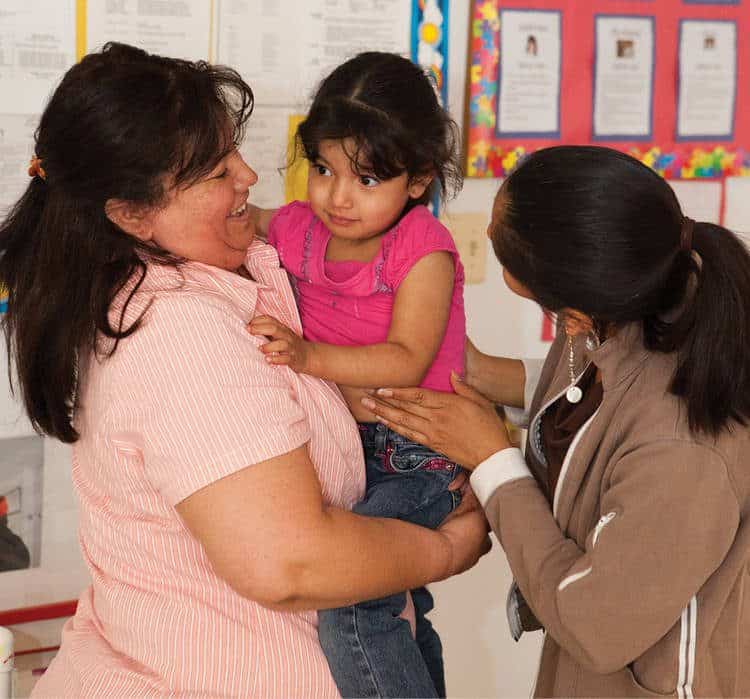Parents and children are a two-for-one deal: Developing positive relationships with parents is critical to providing the best care possible to their children. Here are some approaches for early childhood educators on how to communicate with parents.
Sometimes you already have a relationship with the child’s parents—they may be related to you, live in your neighborhood, or be friends or acquaintances. This can be a real benefit since you might already share an open, trusting relationship with the parents. But this familiarity can also raise some challenges when you are caring for their children.
Even when your relationship with a parent(s) is warm and positive, sharing the care of a young child often stirs up strong feelings. It isn’t uncommon for parents, at one point or another, to feel a pang of fear that their child might grow to love her caregiver more. They may also worry, at times, that their child’s caregiver is better at parenting than they are. This may be more of a concern when the caregiver is someone the parent and child both know well—a relative, friend or neighbor.
Developing a plan together with parents on how to handle a child-rearing issue helps you move forward as partners, instead of competitors.
Here are two fairly typical experiences that come up when sharing the care:
Sarita got into her car, really angry. When she dropped off her 20-month-old, Malika, that morning, she mentioned to her friend, Angela (who cares for Malika), how impossible Malika has been in the mornings. She drags her feet, doesn’t want to get dressed, pitches a fit about which outfit to wear—it’s been practically impossible to get her out the door. Angela seemed really surprised. “Wow, she is an angel here. I tell her it’s time to go out and she runs over to the coat hook, pulls down her coat, and puts it on. She is really cooperative.” Sarita thought she’d be relieved to hear how well-behaved Malika was, but instead found herself wondering if this means she is not as good at caring for Malika.
Aldo stopped by his mother-in-law’s house to pick up his toddler, Blanca. When he tells Blanca it is time to go home, she shouts, “No! Stay with Abuelita!” and goes to hide under the table. After calling to her, Aldo finally had to crawl under there and pull her out. Blanca was screaming the whole time. It was embarrassing, and made him feel like a bad father—like even his own child didn’t want to be with him. His mother-in-law told him it was just because Blanca has a hard time making changes. But it still was a rotten way to end a long day.
Communicating with Parents: 3 Key Steps
When you have a challenging encounter with a parent, you can use the steps below to get things back on track in order to provide the best care for the child you all care so deeply about.
Step 1: Notice how you are feeling.
Tuning in to your feelings is very important. When you’re not aware of them, they often rear their ugly heads in ways that can interfere in building strong, positive relationships with parents.
Adele watches her niece’s son, Eduardo, each day, which she really enjoys. But her niece, Tasha, is often late to pick him up and never calls. Adele is really frustrated and angry. She feels it’s very disrespectful and that she is being taken advantage of. When her niece does eventually show up, Adele is very abrupt and annoyed in her tone. The two adults barely communicate. Eduardo glances from one to the other and looks very tense. Tasha whisks him away and Eduardo doesn’t even say good-bye to his auntie whom he adores.
Recognizing the impact on Eduardo, Adele decides to talk to Tasha about her feelings and to see about making a plan to help Tasha arrive on time, and at least to call to let Adele know she is running late. When Adele takes the approach of partnering with Tasha in solving the problem, versus blaming her, Tasha is open to discussing solutions.
Step 2: Look at the interaction from the child’s point of view.
Tuning in to the child’s experience can reduce tension and lead to joint problem-solving. Take the example of a child throwing a tantrum when his parent comes to pick him up. This situation can naturally make a parent feel incompetent and embarrassed. But if you look at it from the child’s point of view, you can reframe the issue in a way that doesn’t make the parent feel bad and that also helps him or her understand the complexity of the child’s behavior: “It seems like Stephanie is trying to tell you, I’m having so much fun with the dollhouse that I need a little time to adjust to the idea it’s time to leave for the day.”
In the cases where a child is more cooperative with you than the parent, again, help her see it from the child’s perspective: “Yes, Tony puts his coat on when I ask him to, but that’s because he knows I have to help the other kids too. Kids learn quickly that the rules and expectations at home and here can be different. He tells me all about how you make sure he is zipped up and how you always check that he has his hat. He talks about you all the time.”
Step 3: Partner with parents.
Developing a plan together with parents on how to handle a child-rearing issue helps you move forward as partners, instead of competitors. For example, if you are trying to teach children not to hit when they are angry, but the parent hits her child to discipline her at home, you can:
- Use “I” statements: I know we are both concerned about Erica hitting other kids when she’s here. I really work with the kids on finding other ways to show angry feelings. I don’t hit them because when adults hit children when they are angry, it teaches children to hit as well when they are mad.
- Ask for the parent’s perspective: Clarify the parent’s feelings and beliefs on the issue. Ask questions to learn, not to pass judgment: “What are acceptable ways to you for Erica to express her angry feelings? What do you do at home? What do you find works? What doesn’t work? Would you be open to finding ways to discipline her other than hitting?”
- Most important: Look for a place to compromise. Ask the parent if he or she has ideas for next steps. What can the two of you agree on? What can you both work on? For example, “We both agree that Erica needs to find other ways to show her anger besides hitting. One strategy that seems to work here is to have her stomp her feet as hard as she can to get her mad out. Are you comfortable with that? I also tell her that if she needs a break, she can curl up on the couch with her teddy bear. Are these strategies you think you might want to try at home?“ (If not, ask the parent(s) what he or she would be comfortable with.)
- Finally, don’t forget to check in. A relationship is a living thing that grows and changes over time. It’s important to check in with parents to see how things are going, how your agreed-upon plan is working, and where you might need to make some adjustments. Communication is the key to making any partnership work.




